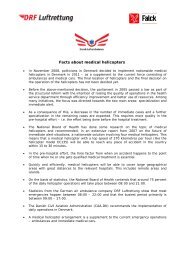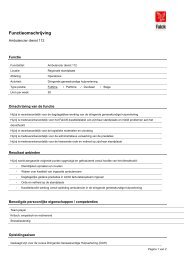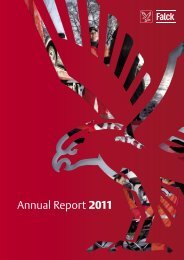Annual Report 2010 - Falck
Annual Report 2010 - Falck
Annual Report 2010 - Falck
You also want an ePaper? Increase the reach of your titles
YUMPU automatically turns print PDFs into web optimized ePapers that Google loves.
58 <strong>Falck</strong> <strong>Annual</strong> <strong>Report</strong> <strong>2010</strong> | Group<br />
Notes to the Group financial statements<br />
Note<br />
1 Accounting policies (continued)<br />
Non-controlling interests<br />
On initial recognition, non-controlling interests are measured<br />
either at fair value (including the fair value of goodwill related<br />
to non-controlling interests in the acquiree) or as non-controlling<br />
interests’ share of the acquiree’s identifiable assets,<br />
liabilities and contingent liabilities measured at fair value<br />
(excluding the fair value of goodwill related to non-controlling<br />
interests’ share of the acquiree). The basis of measurement<br />
of non-controlling interests is chosen on a transaction-bytransaction<br />
basis.<br />
Acquisition and divestment of non-controlling interests<br />
Any increase and reduction of non-controlling interests is<br />
accounted for as transactions with owners in their capacity as<br />
owners. As a consequence of this, any differences between<br />
the adjustment to the carrying amount of non-controlling<br />
interests and the fair value of the consideration received or<br />
paid is recognised directly in equity.<br />
When put options are issued as part of the consideration for<br />
business combinations, the non-controlling interests receiving<br />
put options are considered to have been redeemed on the<br />
acquisition date. The non-controlling interests are removed<br />
and a liability is recognised at fair value on initial measurement.<br />
The fair value is determined as the present value of the<br />
exercise price of the option. The subsequent measurement<br />
is at fair value with recognition in equity of value changes as<br />
they arise.<br />
Issued put options related to business combinations with an<br />
acquisition date prior to 1 January <strong>2010</strong> will continue to be<br />
recognised in accordance with IFRS 3 (2004), i.e. subsequent<br />
measurement takes place at amortised cost with recognition<br />
of interest expenses in the income statement and value<br />
changes in goodwill as they arise. Any subsequent dividend<br />
payments to option holders are recognised as a financial<br />
expense in the income statement in the cases where the option<br />
price is independent of the dividend payment. Dividend<br />
payments are included in the determination of the cost of the<br />
put options in cases where the option price is adjusted for<br />
dividend payments received.<br />
FOREIGN CURRENCY TRANSLATION<br />
A functional currency is determined for each of the reporting<br />
entities of the Group. The functional currency is the currency<br />
in the primary economic environment in which the reporting<br />
entity operates. Transactions in currencies other than the<br />
functional currency are transactions in foreign currencies.<br />
On initial recognition, transactions denominated in foreign<br />
currencies are translated to the functional currency at the<br />
exchange rates ruling at the transaction date. Exchange differences<br />
arising between the exchange rate ruling at the transaction<br />
date and the exchange rate ruling at the date of actual<br />
payment are recognised in the income statement under<br />
financial income or financial expenses.<br />
Receivables, payables and other monetary items denominated<br />
in foreign currency are translated into the functional currency<br />
at the exchange rate ruling at the balance sheet date. The<br />
difference between the exchange rate ruling at the balance<br />
sheet date and the exchange rate ruling at the date when<br />
the receivable or payable arose or the exchange rate applied<br />
in the most recent financial statements is recognised in the<br />
income statement under financial items.<br />
The income statements of foreign subsidiaries are translated<br />
at the exchange rates ruling at the transaction dates, and the<br />
balance sheet is translated at the exchange rates ruling at the<br />
balance sheet date. An average exchange rate for the month is<br />
used as the exchange rate ruling at the transaction date to the<br />
extent that this does not significantly change the presentation<br />
of the underlying transactions. Exchange differences arising<br />
on the translation of the equity of foreign subsidiaries at the<br />
beginning of the year to the exchange rates ruling at the balance<br />
sheet date and on the translation of income statements<br />
from the exchange rate ruling at the transaction date to the<br />
exchange rate ruling at the balance sheet date are recognised<br />
directly in other comprehensive income and are classified in<br />
equity in a separate currency translation reserve. Exchange differences<br />
are allocated between the parent company’s and the<br />
non-controlling interests shares of equity.<br />
Foreign exchange adjustments of balances that are considered<br />
part of the overall net investment in companies with<br />
functional currencies other than DKK are recognised in the<br />
consolidated financial statements directly in other comprehensive<br />
income and classified in equity in a separate currency<br />
translation reserve. Similarly, exchange gains and losses on the<br />
part of loans and derivative financial instruments effectively<br />
hedging the net investment in such companies and which effectively<br />
hedge against corresponding exchange gains/losses<br />
on the net investment in the company are recognised directly<br />
in other comprehensive income and are classified in equity in<br />
a separate currency translation reserve.<br />
On recognition in the consolidated financial statements<br />
of associates with a functional currency other than Danish<br />
kroner, the share of results for the year is translated at average<br />
exchange rates, and the share of equity including goodwill is<br />
translated at the exchange rates ruling at the balance sheet<br />
date. Exchange adjustments arising on the translation of the<br />
share of the opening equity of foreign associates at exchange
















